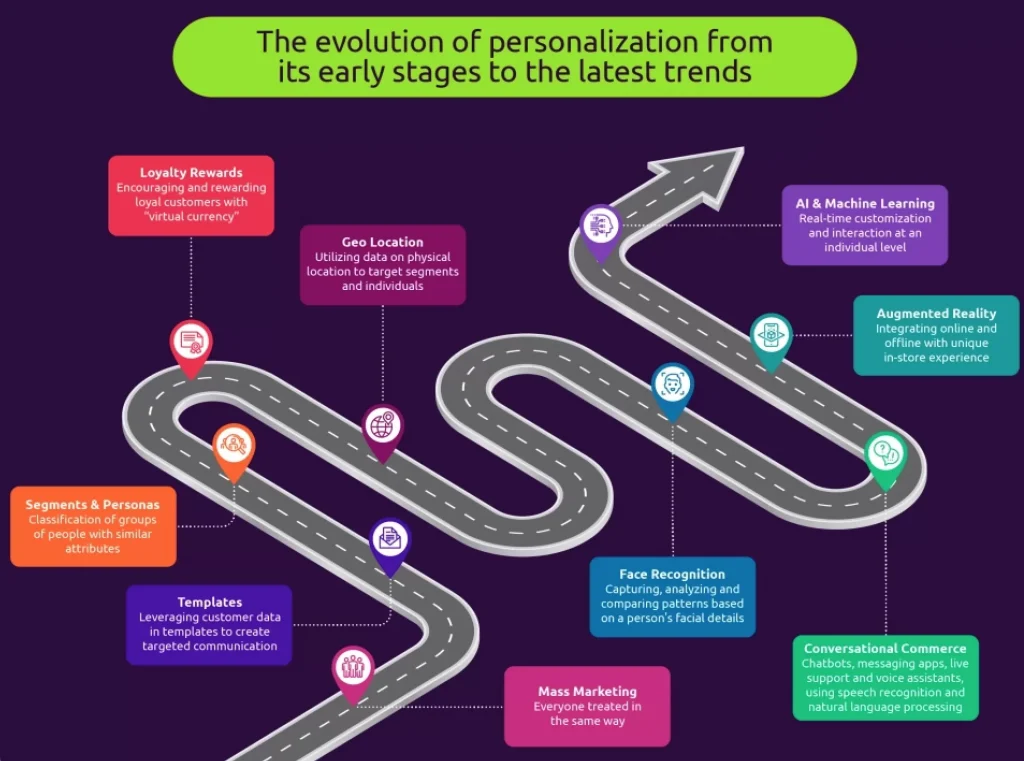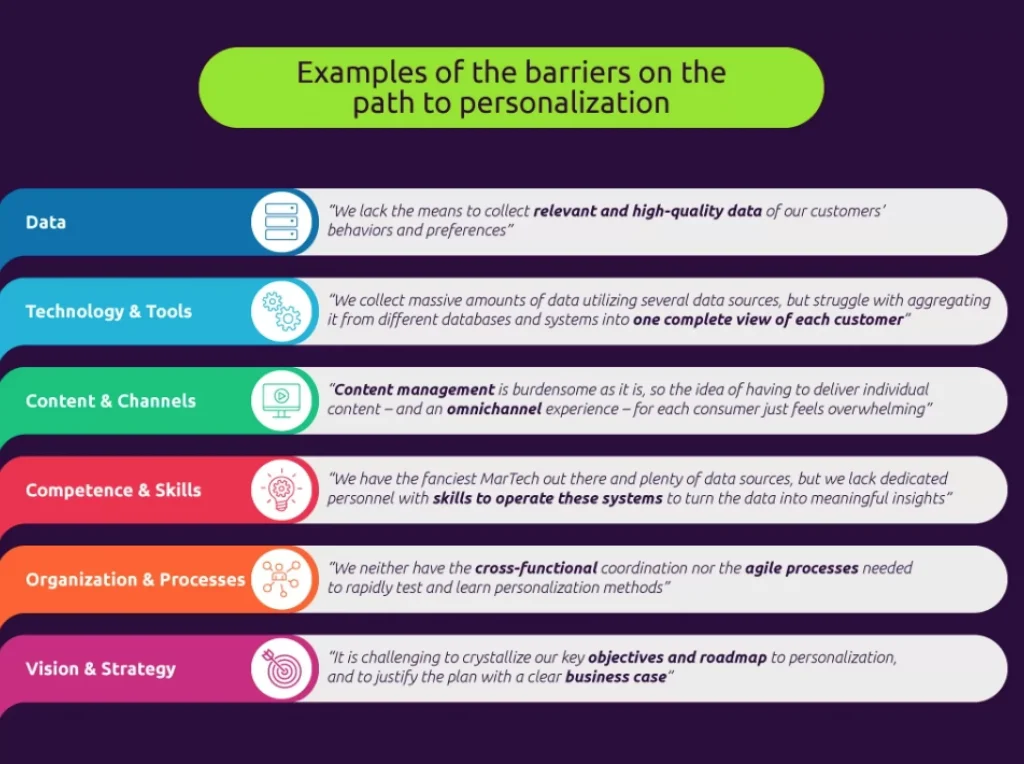Personalisation has been a trend now for over a decade, yet companies still struggle to get it right. This post explores the evolution of personalisation towards a more advanced form of ‘hyper-personalisation.’ It also discusses the key factors that are the reason why organisations still, after ten years, are not able to treat their customers as individuals.
The right message to the right individual, in the right place and time
Personalisation, if done right, creates a highly relevant and intimate interaction between a brand and a consumer. To accomplish this, a company needs to leverage insights on personal, contextual and behavioural data of their consumers (or similar individuals) to deliver an experience that meets customer needs under all circumstances. It all boils down to being able to cater to a specific individual with the right message, in the right place and at the right time.
Personalisation can be applied throughout the customer lifecycle. In the awareness and consideration phase, you may have seen ads for products based on your recent internet searches or product recommendations similar to your past purchases – this is personalisation. When contemplating whether to buy those trendy new trainers, you might have received an email that greeted you by name and asked if you wanted to get back to the cart you had abandoned and complete your order – this is also personalisation.
Once you get to wear your new trainers, there could be a sentiment-detecting customer service chatbot to address your potential questions. Moreover, to foster loyalty, you might be treated with exclusive deals and messages about new product releases – this is also personalisation. Ideally, the customer journey is tailor-made for you, in all phases and interactions.

A win-win for consumers and companies
This technological shift, where we have gone from transactional one-size-fits-all experiences towards hyper-personalised experiences, has also altered consumer expectations.
According to the Salesforce ‘State of the Connected Customer’ report (2019), 73% of customers expect companies to know and understand their individual needs and expectations. At the same time, 64% of customers expect the companies to also act on the information they possess and to provide them with tailored engagements based on past interactions. The report also highlights that approximately the same portion would even be willing to pay extra for an exceptional experience.
Some of the most sought-after benefits by consumers are high relevancy and added convenience, as discovering meaningful products and content is made effortless for them. Personalisation also tends to enable smoother interactions with brands thanks to consistency across touchpoints and the availability of swift personal support. Meeting customer expectations such as the above also proves beneficial to companies; efforts in this area could translate into higher customer lifetime value through improved conversion, increased cross and upsell, higher customer satisfaction and improved loyalty. Aren’t all companies already on top of it?
Many well-known companies are great at providing their customers with individualised brand experiences. Netflix is an obvious example, with their recommendation engine that most of us have fallen victim to. And companies such as Starbucks, Nike, Disney and Sephora, to name a few, also have made good use of personalisation elements. These range from loyalty apps providing individualised offers and releases, online services to personalise physical goods, augmented reality features to try on products, geo-location capabilities and predictive analytics to personalise entire on-site consumer experiences.
However, despite all the successful use cases out there, most companies still fall short of customer expectations. According to Salesforce (2019), 52% of customers report that the companies they interact with feel impersonal.
At the same time, companies worry about not having adequate skills to enable personalisation. According to the 2019 Gartner Marketing Symposium polls 60% of marketing professionals feel that they do not have an effective strategy and roadmap to make it happen. This dilemma can easily lead to situations where the efforts just end up going terribly wrong. Unfortunate examples are sadly numerous, such as Mother’s Day greetings being sent to women struggling with infertility, due to a poor personalisation attempt.

Effective personalisation relies on mastering skills across the marketing functions
Providing each consumer with the right message, at the right time and place is complicated. Old segmentation and persona-based targeting methods are simply not sophisticated enough to manage the great variety and detail of individual needs and preferences. Sophistication requires a more complex marketing engine. Into the fray comes AI machine learning hyper-personalisation solutions, of varying distinction.. It personalises product selection for email marketing. Only ever sending consumers products personally selected for them, based on their own unique personal buying history and impressions.
Clicks and purchases create a perpetual pattern created of that individual, from all their interaction with your website. So sending them details of only those products they are most likely to buy, based on their actions, not only has a fundamentally positive effect on that individual – they appreciate you knowing them as individuals, and consequently stay loyal, spend more, return less.
Most importantly returns are far greater than experienced from existing solutions. A company lacking the required skills at the level of marketing strategy will find it challenging to specify the objectives and roadmap towards hyper-personalisation or justify it with a business case. Contrarily, they could have a good understanding of the commercial context and have a vision in place, yet may lack an organisational set-up for cross-functional coordination or agile processes.
Sometimes the barriers are related to shortcomings in execution, such as a lack of competent individuals to operate the existing MarTech applications and turn data into meaningful insights. On the other hand, the struggles may result from a poor (or non-existent) content management solution that makes it virtually impossible to maintain and deliver hyper-personalised content to each consumer.
The very foundation of hyper-personalisation is constituted by data and technology. Even if there is a huge amount of data collected and stored, the inability to aggregate it and make it autonomously actionable is a major obstacle for many organisations.
It’s time for personalisation to become a priority
To sum up, the barriers that companies face on the path to personalisation may vary. Only when all the boxes are checked can they effectively deliver meaningful tailored experiences to the consumers and meet ever-evolving expectations. Although striving towards the more advanced levels of hyper-personalisation might not be a relevant aim for all organisations, companies ought to start assessing their maturity, setting simple, feasible goals and building relevant skill sets to stay ahead of the competition.





